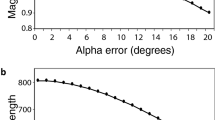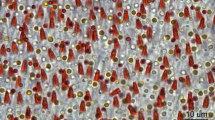Summary
Previous papers (Blest andPrice 1984,Blest andSigmund 1984) have described the receptor mosaics in the tiered principal retinae of jumping spiders with high and low visual acuities, respectively. The latter paper offers a phylogenetic model for the later stages in the evolution of high acuity retinae in which layer I, farthest from the dioptrics, is alone required to sustain fine visual discriminations. Nevertheless, current evidence does not establish that the low acuity principal retinae of primitive jumping spiders were modified to yield the high acuity retinae of advanced forms: each might have evolved independently from a common precursor.
We now show that the principal retina ofSpartaeus (the type genus of a primitive subfamily, theSpartaeinae) is a true intermediate between the low acuity retina ofYaginumanis and the high acuity retina ofPortia (also in theSpartaeinae).
InSpartaeus, foveal layer I receptors at the anatomical outer side of the retina each bear a single rhabdomere designed as a light guide. Inner layer I receptors each have two rhabdomeres, and rhabdomeres of horizontally adjacent receptors are contiguous, so that optical pooling limits their acuity. Horizontal “staircasing” of the tips of layer I receptors was shown byBlest et al. (1981) to cause outer receptors to receive focused images from remote planes in object space, and inner receptors from nearer planes. In the high-acuity retina ofPortia all foveal layer I receptors are light-guides, and in the low-acuity retina ofYaginumanis none are. Layer I inSpartaeus, therefore, is a true intermediate step in the evolution of a high-acuity retina, and the local region of the foveal layer I mosaic modified to that end is concerned, appropriately, with the resolution of distant objects.
The layer II mosaic is degraded, although less so than inPortia. Layer III is conservative throughout theSalticidae. Foveal layer IV exhibits greater homogeneity inSpartaeus than in other forms.
Similar content being viewed by others
References
Blest, A. D., 1983: Ultrastructure of the secondary eyes of primitive and advanced jumping spiders (Salticidae: Araneae). Zoomorphology102, 125–141.
—, 1984 a: Secondary retinae of a primitive jumping spiderYaginumanis (Arachnida, Araneida, Salticidae). Zoomorphology104, 223–225.
—, 1984 b: The fine structure of spider photoreceptors in relation to function. In: The neurobiology of arachnids (Barth, F. G., ed.). Berlin-Heidelberg-New York: Springer (in press).
—,Hardie, R. C., McIntyre, P., Williams, D. S., 1981: The spectral sensitivities of identified receptors and the function of retinal tiering in the principal eyes of a jumping spider. J. comp. Physiol. A145, 227–239.
—,Hardie, R. C., McIntyre, P., Williams, D. S., Price, G. D., 1984: Retinal mosaics of the principal eyes of some jumping spiders (Salticidae: Araneae): adaptations for high visual acuity. Protoplasma120, 172–184.
—,Hardie, R. C., McIntyre, P., Williams, D. S., Sigmund, C., 1984: Retinal mosaics of the principal eyes of two primitive jumping spiders,Yaginumanis andLyssomanes: clues to the evolution of Salticid vision. Proc. R. Soc. Lond. B221, 111–125.
Crane, J., 1979: Comparative biology of salticid spiders at Rancho Grande, Vnezuela. IV. An analysis of display. Zoologica N.Y.34, 159–214.
Eakin, R. M., Brandenburg, J., 1971: Fine structure of the eyes of jumping spiders. J. Ultrastruct. Res.37, 618–663.
Jackson, R. R., Blest, A. D., 1982 a: The distances at which a primitive jumping spider makes visual discriminations. J. exp. Biol.97, 441–445.
—,Blest, A. D., 1982 b: The biology ofPortia fimbriata, a web-building jumping spider (Araneae: Salticidae) from Queensland: utilization of webs and predatory versatility. J. Zool. Lond.196, 255–293.
Land, M. F., 1969 a: Structure of the retinae of the eyes of jumping spiders (Salticidae: Dendryphantinae) in relation to visual optics. J. exp. Biol.51, 443–470.
—, 1969 b: Movements of the retinae of jumping spiders (Salticidae: Dendryphantinae) in response to visual stimuli. J. exp. Biol.51, 471–493.
Wanless, F. R., 1984: A review of the spider subfamilySpartaeinae nom. nov. (Araneae: Salticidae) with descriptions of six new genera. Bull. Brit. Mus. nat. Hist. Zool.46 (2), 135–205.
Williams, D. S., McIntyre, P., 1980: The principal eyes of a jumping spider have a telephoto component. Nature Lond.288, 578–580.
Yamashita, S., Tateda, H., 1976: Spectral sensitivities of jumping spider eyes. J. comp. Physiol.105, 29–41.
Author information
Authors and Affiliations
Rights and permissions
About this article
Cite this article
Blest, A.D., Sigmund, C. Retinal mosaics of a primitive jumping spider,Spartaeus (Salticidae: Araneae): A transition between principal retinae serving low and high spatial acuities. Protoplasma 125, 129–139 (1985). https://doi.org/10.1007/BF01297358
Received:
Accepted:
Issue Date:
DOI: https://doi.org/10.1007/BF01297358




